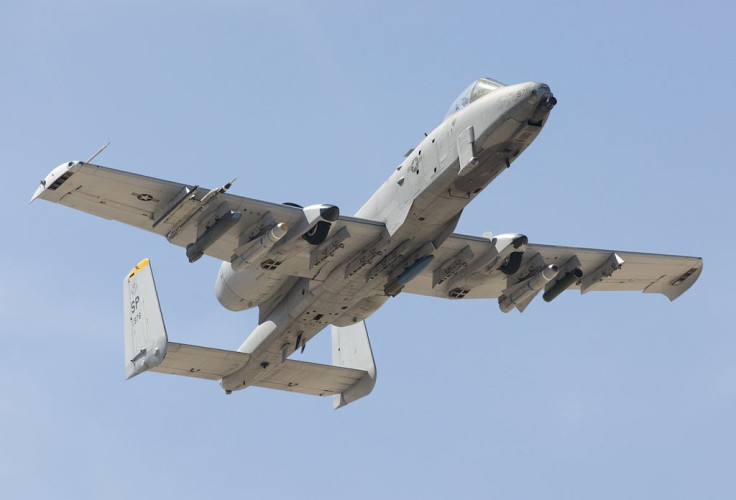Republican Victory And John McCain Is Good News For The A-10 Thunderbolt, Bad News For The F-35

One of the consequences of the Republican win in this week's midterm elections is that the A-10 Thunderbolt aircraft, a warplane that had been on the chopping block due to budget cuts but is popular with U.S. troops, will probably survive for a few more years. That's because the plane has powerful friends among the Senate's new Republican majority. But that creates a battle for resources with the Air Force's newest, and most expensive project, the Lockheed Martin F-35.
“It’s unlikely that Congress will go along with its retirement a year from now, or even a couple of years from now,” said Benjamin Friedman, a research fellow in defense and homeland security studies at the libertarian-leaning, Washington-based Cato Institute. “The A-10 has always had a hard time in the Air Force, which is focused on strategic bombing and fighter aircraft and has traditionally given less support to close air support aircraft like the A-10.” The Warthog, as it's commonly known by aircrews, is well-liked by ground troops, who often rely on its ability to fly low and hit enemy troops with lethal accuracy.
The A-10 was tagged for retirement by the Air Force in 2015, but a powerful lobby headed by Senators John McCain of Arizona and Kelly Ayotte of New Hampshire fought successfully to have the aircraft’s life extended by an extra year. The plane has since been deployed to the Middle East, where its ground attack ability will offer the U.S.-led coalition a valuable tool against the Islamic State group.
While the Democrat-led Senate voted to lengthen its lifespan, the now Republican-led Senate will very likely try to extend it much further. But in doing so, it raises serious logistical issues for the F-35's introduction, penciled in for 2016.
The problem comes in two parts. The Republican victory takes McCain to the helm of the Senate Armed Services Committee, which wields considerable power on all things military. In addition to being one of the leading advocates for the A-10 and the main reason the aircraft survived cuts in 2015, he’s also a major opponent of large, expensive military projects like the F-35, which is expected to cost in excess of $1 trillion by the end of its lifespan in 2055.
It’s already been noted that McCain will scrutinize the project closely when he takes over the committee.
But perhaps more crucially for the Air Force, the longer the A-10 remains in service the more it hurts the F-35 and endangers its expected delivery. Lt. Gen. Christopher C. Bogdan, the F-35 program executive, says that in the planning for the F-35, 800 aircraft maintainers were to be pulled from personnel working on the A-10 and added to the pool of F-35 maintainers, which would number around 1,100 in total. That plan is now in disarray.
“I am very worried now that my promise to [the Air Force] to give them all the things they need to declare IOC [initial operational capability] on Aug. 1 of 2016. I might not be able to give them,” Bogdan told reporters Oct. 30, before the Republican victory.
However, Ayotte said that there will be enough funds to see both aircraft flourish.
“Suggesting that we must prematurely retire the A-10 to fulfill long-anticipated maintenance requirements for the F-35A is a false choice,” Ayotte wrote in an email to the Military Times. “There are a variety of steps the Air Force can take to maintain the combat-proven and cost-efficient A-10, while also providing sufficient maintenance personnel for the F-35A.
“Rather than threatening to unnecessarily undermine the maintenance of the F-35A, which the Air Force has said is one of its top three acquisition priorities, I hope the Air Force will listen to our ground troops and end its dangerous and misguided effort to deprive our troops of the A-10, which is the aircraft that is most likely to help them survive a firefight with the enemy,” Ayotte said.
McCain, who served and was captured in the Vietnam War as a fighter-bomber pilot, called the A-10 “the finest close-air-support weapon in history.” It does offer a far more accurate troop-support platform than even the highly advanced F-35, a much faster, much more sophisticated jet that wasn't built for ground attack.
But the Cato Institute's Friedman isn’t convinced that the Air Force ever really wanted to get rid of the aircraft. “I think the Air Force is engaged in this using a little bit of political gamesmanship,” he said. Seemingly, the only people that don’t want the A-10 around are F-35 officials. Now, a McCain leadership may just have complicated their life.
© Copyright IBTimes 2024. All rights reserved.






















